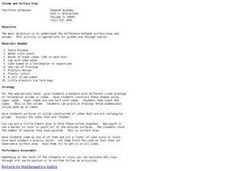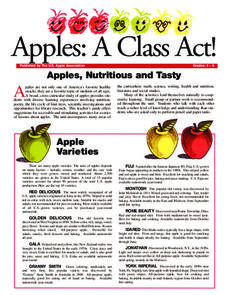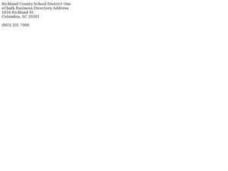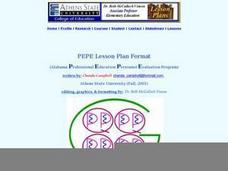Curated OER
Children's Museum of Houston - Pre/Post Classroom Activities - Nets
Students make three dimensional shapes with nets. In this nets lesson, students receive nets which they fold to make a three dimensional object. They predict what shape each net will make and verify it after making the net. They use the...
Curated OER
Volume and Surface Area, A Sweet Activity
Geometry.... sweet! Using sugar cubes, learners build rectangular prisms of different sizes and shapes. They glue them together and assess volume. Then they color the outer sides to visualize and compute surface area. To make a visceral...
Curated OER
Prisms, Pyramids, and Nets
Students compare and contrast the characteristics of prisms and pyramids. In groups, they are given different colored construction paper to make rectanglar prisms. They identify the shapes of the faces and record the number of faces,...
Curated OER
Opening A Cube
Fifth graders investigate mathematical concepts related to the construction of a three dimensional cube. They construct the cube from two dimensional patterns and compute the surface area. Students also define the faces, edges, and...
Curated OER
Comparing Measurements
Students explore measurements by completing worksheets in class. In this geometry lesson, students identify the basic measurement units in both the English and metric systems. Students analyze 2 and 3 dimensional objects and identify...
US Apple Association
Apples: A Class Act! (Grades 4–6)
Middle schoolers have a bushel of fun as they engage in activities and research core facts about apples. Packed with suggestions for in-class activities and out-of-class research, the colorful 6-page packet is sure to satisfy hungry...
Curated OER
Faces of a Cube
Young scholars identify and correctly name three-dimensional solids; cones, spheres, and cubes. In this three-dimensional figures lesson, students build a cube by matching colored square faces to a correct word. Young scholars then...
Curated OER
A World of Symmetry
Middle schoolers identify lines of symmetry. In this symmetry lesson, students create objects and identify their lines of symmetry. They answer questions about lines of symmetry. Middle schoolers cut shapes out of cookie dough and...
Curated OER
Volume and Surface Area of Right Rectangular Prisms
Students identify the formulas for three-dimensional figures. They use manipulatives to model problems. Students create foldables and explain volume and surface area. Students complete worksheets and classify solids. Students sing a...
Curated OER
Volume
Students, after reviewing the measuring of the lengths of sides of different shapes along with the calculation of their perimeters and areas, encounter what it means by the 'perimeter' of a polygon. They practice measuring units of...
Curated OER
Building a Box
Students create different two dimensional nets that can be folded to create a cube. In this visual spacial awareness lesson, students explore different ways that two-dimensional objects can be laid out to create a three dimensional cube.
Curated OER
Math: Shapes and More Shapes
Students locate lines of symmetry in regular polygons and predict the number of lines of symmetry in an octagon. In three different polygons, they construct all lines of symmetry and after making their prediction about the octagon,...
Curated OER
What Shape Is Money? Money Doesn't Have to Be Round or Rectangular
Students explain that many kinds of objects have been used as money. After identifying qualities that make a good currency, they design a nontraditional currency and decide on its value.
Curated OER
Scale Factor- Surface Area and Volume
Young scholars calculate the surface area and volume of shapes. In this geometry lesson plan, students create different scales and calculate the volume and area for each shape. They compare and contrast between the different scales and...
Curated OER
2D Polygons and 3D Nets
Students compare and contrast two dimensional polygons and three dimentional nets by examining the differences in drawings. They create three dimensional shapes and label the faces, edges, and vertices. After creating the shapes, they...
Curated OER
Area of Complex Figures
Fifth graders use formulas for calculating areas of squares and rectangles to find area of complex figure, compare their own ideas with their classmates' ideas, and recognize that there are multiple methods for finding area of complex...
Curated OER
Troublesome Towers
Students observe solids and identify parts that make up the surface area. In this geometry lesson, students calculate the surface are of solids and cones. They find polygons and solids in the real world.
Curated OER
Study Buddies - Bar Graphs
In this data collection worksheet, students work with a partner to make 3 small bar graphs after finding the proper number of circles on the first page. They look at a page of a variety of shapes and separate the circles into black,...
Curated OER
Pyramids & Prisms: Guler's Formula
Sixth graders compare and contrast two-dimensional shapes to three-dimensional shapes. After watching a demonstration, they make their own shapes using nets printed on paper. To end the activity, they use the shapes they made and...
Curated OER
Marshmallow Geometry
Third graders create 2D and 3D shapes using marshmallows and toothpicks. In this geometry instructional activity, 3rd graders create their shapes and document the number of faces, edges, corners, angles, and sides. They share one shape...
Curated OER
Math: Symmetry and Similarity
Learners describe the differences between congruence and similarity. After explaining the motions that indicate congruency of two shapes, they complete worksheets to draw lines of symmetry and similar shapes. With straws and twist...
Curated OER
Measuring and Predicting Capacity
Students investigate geometric shapes through volume and dimensions. In this geometry lesson, students measure, weigh, and calculate sizes and volume based on estimation and calculation. They review important vocabulary related to prisms...
Curated OER
Capacity and Volume
Second graders estimate capacities, compare pints and quarts, and identify pints and quarts.
Alabama Learning Exchange
Pennies, Pennies and More Pennies
Learners determine the number of pennies needed to fill a room. In this pennies lesson plan, students work in groups to determine the number of pennies needed to fill a room. They compute the probability of the head of a pin landing on...

























